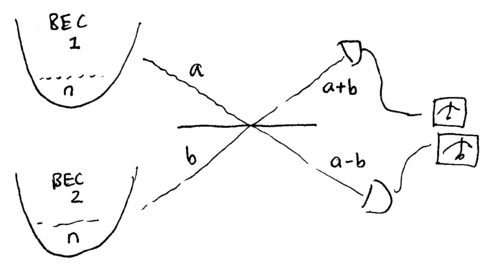Heisenberg-limited interferometry can also be accomplished using a
variety of states of light, including squeezed states we studied earlier. Let us explore three configurations here.
Vacuum squeezed state input
Because squeezed states can move
noise between the  and
and  quadratures, it is intuitively
reasonable that a state with low phase noise could be used to provide
more accurate measurements of
quadratures, it is intuitively
reasonable that a state with low phase noise could be used to provide
more accurate measurements of  than is possible with a coherent
state, which has equal noise in the two quadratures.
than is possible with a coherent
state, which has equal noise in the two quadratures.
It might seem counter-intuitive, however, that we can get to the
Heisenberg limit by replacing not the coherent state input, but
rather, the vacuum state, in the Mach-Zehnder interferometer. This
works because at the balanced operating point, the noise in the output
is due to fluctuations entering in at the vacuum port. Before, we
used  as input. Let us now replace this by
as input. Let us now replace this by

where  is a squeezed vacuum state. Recall that for
the balanced interferometer, the final uncertainty in the phase
measurement is
is a squeezed vacuum state. Recall that for
the balanced interferometer, the final uncertainty in the phase
measurement is

where  , and
, and  . For the squeezed
vacuum + coherent state input, we find
. For the squeezed
vacuum + coherent state input, we find

Thus, the uncertainty in the phase measurement is approximately

In the limit of large squeezing, ie  , the squeezed
vacuum has nonzero average photon number,
, the squeezed
vacuum has nonzero average photon number,  , so this expression does not vanish to zero. Rather, there
is an optimal amount of squeezing, at which point the minimum phase
uncertainty goes as
, so this expression does not vanish to zero. Rather, there
is an optimal amount of squeezing, at which point the minimum phase
uncertainty goes as  , which is
close to the Heisenberg limit. See <refbase>184</refbase>
, which is
close to the Heisenberg limit. See <refbase>184</refbase>
Yurke state input.
The Heisenberg limit can also be reached
using the Mach-Zehnder interferometer by replacing the input light
states with this unusual squeezed state
![{\displaystyle |\psi _{in}\rangle ={\frac {1}{\sqrt {2}}}\left[{|n-1{\rangle }|n\rangle +|n{\rangle }|n-1\rangle }\right]\,.}](https://wikimedia.org/api/rest_v1/media/math/render/svg/fddaf8eca4a41d65a799f1448a487eafc95e3022)
This is known as the Yurke state. It happens to be balanced
already, and thus instead of operating our interferometer at
 , we operate it at
, we operate it at  , such that the output
measurement gives
, such that the output
measurement gives  , and
, and  , and the
final uncertainty in the phase measurement is
, and the
final uncertainty in the phase measurement is

For the Yurke state,

In calculating  , the terms with
, the terms with  drop out, leaving us with
drop out, leaving us with

Similarly, it is straightforward to show that

Thus, the uncertainty in  is
is

which is the Heisenberg limit.
Yurke state: Experiment?
Given how useful the Yurke state could be for interferometry, it is
meaningful to consider how such a state might be made. One
interesting proposal starts with two Bose-Einstien condenstates,
prepared in a state of definite atom number, which we may model as two
number eigenstates  . The two condensates are weakly linked
through a tunnel, which we may model as a beamsplitter, and detectors
are placed to look for a single atom at the outputs. This is sketched
below:
. The two condensates are weakly linked
through a tunnel, which we may model as a beamsplitter, and detectors
are placed to look for a single atom at the outputs. This is sketched
below:
If the top detector clicks, then one atom has left the condensates;
however, it is unknown from which it came. The post-measurement
state, after this single click, is thus

written unnormalized. Normalized, the proper post-measurement state
is

This is the Yurke state. If the bottom detector had clicked instead,
we would have obtained  instead, which is also
useful.
instead, which is also
useful.
Similar techniques, involving beamsplitter mixed detection of
spontaneous emission, can be used to entangle atoms (as we shall see
later). More about this BEC entanglement method can be found in the
literature; see, for example, <refbase>185</refbase>
, for the proposal to create Yurke states;
<refbase>186</refbase>,
for an experiment in which a squeezed BEC state was generated, and
<refbase>187</refbase>, for a
proposal to do Heisenberg limited spectroscopy with BECs.














![{\displaystyle |\psi _{in}\rangle ={\frac {1}{\sqrt {2}}}\left[{|n-1{\rangle }|n\rangle +|n{\rangle }|n-1\rangle }\right]\,.}](https://wikimedia.org/api/rest_v1/media/math/render/svg/fddaf8eca4a41d65a799f1448a487eafc95e3022)















